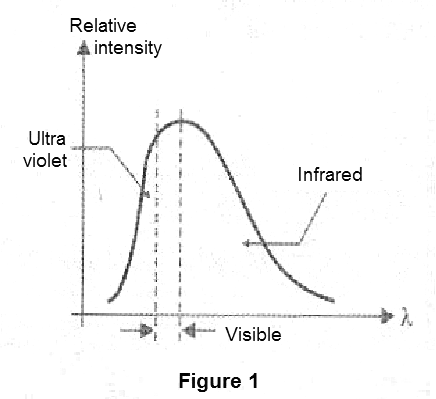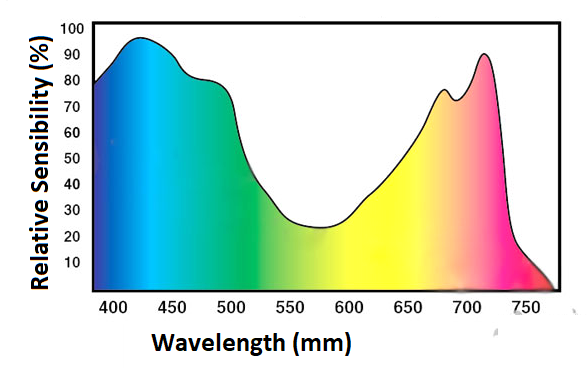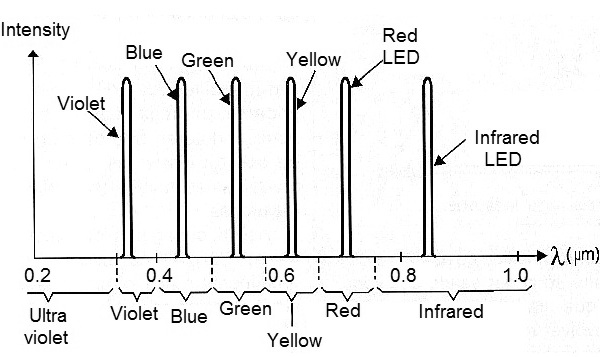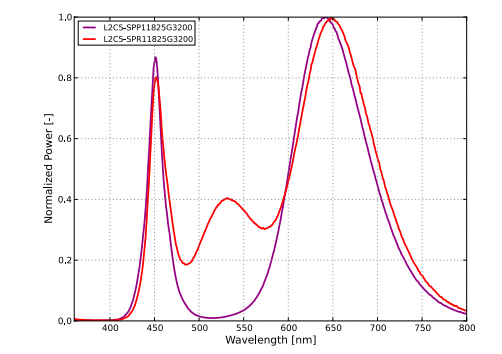In the past, greenhouses used ordinary incandescent bulbs which emitted only a small portion of their energy for plant utilization. That meant a huge waste, as it always did with this kind of lighting under normal conditions.
In fact, the portion of the spectrum which an ordinary incandescent lamp emits and which we can see working, therefore, for illumination is very small.
The rest is wasted, infrared and a small portion of the ultraviolet which consume energy also generating heat is not used. Less than 25% of what is spent with a lamp of this type reverts in light for illumination. Figure 1

If we consider that within the narrow band of the visible, plants only use for their metabolism a part of the light which extends from blue to green and with a peak in red, as shown in Figure 2.

Thus, if we can direct the emission of an LED to the bands where the utilization is greater, it is possible to obtain a performance which compensates the investment in this type of emitting source.
Knowing this, several manufacturers direct their products so that they just emit light in the bands where the use of the plant is greater.
In greenhouses, these LEDs have a much better use of the energy.
Note that LEDs are produced with multiple chips, such as white or RGB LEDs that, with proper power, produce the desired spectrum with the highest performance.
We note that the LEDs operate with narrow emission bands, as shown in Figure 3.

But it is not only in greenhouses that LEDs with appropriate features to the absorption of plants find applications.
In indoor gardens, even in homes where a crop is desired in a place where there is no natural light, using small LED luminaires can ensure not only the survival of plants but their healthy growth.
There are several manufacturers of horticulture LEDs that resell their products through Mouser Electronics. Let's cover the products of some of them.
Manufacturers and Products
One of the manufacturers that has specific products for horticulture, which are distributed by Mouser Electronics is LumiLEDs.
This company owns the Luxeon SunPlus CoB line which has products designed to get maximum plant penetration.
In Figure 4, we have the emission curve of these LEDs, which, as we see, corresponds exactly to the absorption curve of the common plants shown in Figure 2.

In extensive documentation on the use of this line of LEDs, Luxeon shows you how to use their products in horticulture. The reader can access documentation at: https://www.mouser.com/datasheet/2/602/DS195-1371856.pdf
On the page of the following link, you can access the entire line of LEDs for horticultural applications available at Mouser: https://www.mouser.com/Optoelectronics/LED-Emitters/_/N-ec209?Keyword=horticulture&FS = True
Another company that manufactures LEDs for horticultural applications and that makes their products available at Mouser Electronics is the Engin LED. On the same page previously recommended we have access to the products of this company.
An example of LED for applications in horticulture of the Engin LED is the LPZ00H100 of 70W of power able to emit radiation at the critical wavelengths for this application.
On the following page, the reader can access the datasheet of this component: https://www.mouser.com/datasheet/2/228/LZP-00H100-1222657.pdf
Another major manufacturer of LEDs for horticulture is Wurth which provides through Mouser Electronics several LEDs with specific emission range for this application.
An example is the 150353DS74500 whose datasheet can be accessed at: https://www.mouser.com/datasheet/2/445/150353DS74500-1313736.pdf. With a dissipation of 250 W this component operates with a current of 700 mA.
We have completed the series of LED horticulture manufacturers with Opulent whose line can be accessed on the same page as this article.
Conclusion
The ever-increasing possibility of high-tech products interacting with our environment world, including animals and plants, is leading to the development of specific products.
In addition to horticulture, we can even think about products which we have not yet seen and that can be perfectly researched by readers. The response of a search to insect light can lead, for example, to the creation not only of ecological traps but also the attraction of predatory insects which attack pests.
Certainly, it is a subject that can feed the imagination of our readers. Creating new products with new technologies can be very interesting (and profitable), but remember what we always talk about on this site: you need to know about other disciplines besides technology (interdisciplinary and convergence).



